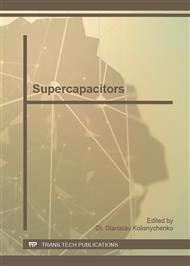p.1267
p.1271
p.1275
p.1283
p.1290
p.1299
p.1304
p.1308
p.1314
The Electrochemical Characterization of Electrochemically Synthesized MnO2-Based Mixed Oxides for Supercapacitor Applications
Abstract:
Nanostructured elements, including: manganese-molybdenum (Mn-Mo) oxide, manganese-molybdenum-tungsten (Mn-Mo-W) oxide, manganese-molybdenum-iron (Mn-Mo-Fe) oxide, manganese-molybdenum-cobalt (Mn-Mo-Co) oxide, manganese-vanadium-tungsten (Mn-V-W) oxide, manganese-vanadium-iron (Mn-V-Fe) oxide and manganese-iron (Mn-Fe) oxide, have been anodically deposited onto titanium substrates by employing an iridium dioxide interlayer (Ti/IrO2 anode). The electrochemical characteristics of the resultant oxide deposits have been investigated by cyclic voltammetry (CV) in an aqueous 0.1 M Na2SO4 solution. The voltammetric behaviors of the oxide deposits observed are significantly influenced by the doped elements. Molybdenum doping is found to be advantageous at improving the capacitance characteristics of anodically deposited manganese oxide. Comparatively, iron and vanadium doping are found to be unfavorable. The structure and crystallinity of these deposits have been identified by X-ray diffraction (XRD). The surface morphologies of these oxides were acquired from field emission scanning electron microscopes (FESEM). The high values of electrical parameters for the doped deposits are attributed to the net-like and sponge-like nanostructure, and low crystallinity of the doped manganese oxides. The deposit of Mn-Mo oxides exhibits an excellent capacitive-like behavior, possessing the maximum specific capacitance of 810 F g-1 at a CV scan rate of 5 mV s-1 in aqueous 0.1 M Na2SO4 solution.
Info:
Periodical:
Pages:
1290-1298
Citation:
Online since:
July 2011
Authors:
Price:
Сopyright:
© 2011 Trans Tech Publications Ltd. All Rights Reserved
Share:
Citation:



